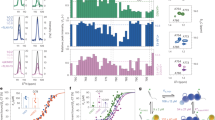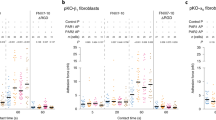Abstract
The α4 integrins are indispensable for embryogenesis, haematopoiesis and immune responses1,2, possibly because α4 regulates cellular functions differently from other integrins through its cytoplasmic tail3. We used novel mimics4 of the α4 tail to identify molecules that could account for α4-specific signalling. Here we report that the α4 tail, but not several other α-subunit tails, binds tightly to the signalling adaptor paxillin. Paxillin physically associated with α4 integrins in Jurkat T cells at high stoichiometry, and joining the α4 tail to αIIb resulted in a complex of integrin αIIbβ3 with paxillin. This association markedly enhanced the rates of αIIbβ3-dependent phosphorylation of focal adhesion kinase and cell migration. It also reduced cell spreading, focal adhesion and stress fibre formation. A point mutation within the α4 tail that disrupts paxillin binding reversed all of these effects. Furthermore, α4β1-dependent adhesion to VCAM-1 led to spreading of mouse embryonic fibroblasts derived from paxillin-null but not from wild-type mice. Thus, the tight association of paxillin with the α4 tail leads to distinct biochemical and biological responses to integrin-mediated cell adhesion.
This is a preview of subscription content, access via your institution
Access options
Subscribe to this journal
Receive 51 print issues and online access
$199.00 per year
only $3.90 per issue
Buy this article
- Purchase on Springer Link
- Instant access to full article PDF
Prices may be subject to local taxes which are calculated during checkout






Similar content being viewed by others
References
Stewart,M., Thiel,M. & Hogg,N. Leukocyte integrins. Curr. Opin. Cell Biol. 7, 690–696 (1995).
Shimizu,Y., Rose,D. M. & Ginsberg,M. H. Integrins in the immune system. Adv. Immunol. 72, 325–380 (1999).
Hemler,M. E., Kassner,P. D. & Chan,B. M. C. Functional roles for integrin alpha subunit tails. Cold Spring Harbor Symposia on Quant. Biol. 57, 213–220 (1992).
Pfaff,M., Liu,S., Erle,D. J. & Ginsberg,M. H. Integrin β tails differentially bind to cytoskeletal proteins. J. Biol. Chem. 273, 6104–6109 (1998).
Williams,M. J., Hughes,P. E., O'Toole,T. E. & Ginsberg,M. H. The inner world of cell adhesion: integrin tails. Trends Cell Biol. 4, 109–112 (1994).
Sastry,S. K. & Horwitz,A. F. Integrin tails: mediators of cytoskeletal linkages and extra- and intracellular initiated transmembrane signaling. Curr. Opin. Cell Biol. 5, 819–831 (1993).
Shibanuma,M. et al. Induction of senesence-like phenotypes by forced expression of the hic-5, which encodes a novel LIM motif protein, in immortalized human fibroblasts. Mol. Cell. Biol. 17, 1224–1235 (1994).
Lipsky,B. P., Beals,C. R. & Staunton,D. E. Leupaxin is a novel LIM domain protein that forms a complex with PYK2. J. Biol. Chem. 273, 11709–11713 (1998).
Hagmann,J., Grob,M., Welman,A., van Willigen,G. & Burger,M. M. Recruitment of the LIM protein hic-5 to focal contacts of human platelets. J. Cell Sci. 11, 2181–2188 (1998).
Hughes,P. E. et al. Suppression of integrin activation: a novel function of a Ras/Raf-initiated MAP kinase pathway. Cell 88, 521–530 (1997).
Turner,C. E. Paxillin. Int. J. Biochem. Cell Biol. 30, 955–959 (1998).
Ilic,D. et al. Reduced cell motility and enhanced focal adhesion contact formation in cells from FAK-deficient mice. Nature 377, 539–544 (1995).
Cary,L. A., Chang,J. F. & Guan,J.-L. Stimulation of cell migration by overexpression of focal adhesion kinase and its association with Src and Fyn. J. Cell Sci. 109, 1787–1794 (1996).
Kassner,P. D., Alon,R., Springer,T. A. & Hemler,M. Specialized functional properties of the integrin α4 tail. Mol. Biol. Cell 6, 661–674 (1995).
Hemler,M. E. Integrin associated proteins. Curr. Opin. Cell. Biol. 10, 578–585 (1998).
Lauffenburger,D. A. & Horwitz,A. F. Cell migration: a physically integrated molecular process. Cell 84, 359–369 (1996).
Parsons,J. T. & Parsons,S. J. Src family protein tyrosine kinases: cooperating with growth factor and adhesion signaling pathways. Curr. Opin. Cell Biol. 9, 187–192 (1997).
Hanks,S. K. & Polte,T. R. Signaling through focal adhesion kinase. Bioessays 19, 137–145 (1997).
Klinghoffer,R. A., Sachsenmaier,C., Cooper,J. A. & Soriano,P. Src family kinases are required for integrin but not PDGFR signal transduction. EMBO J. 18, 2459–2471 (1999).
Fincham,V. J. & Frame,M. C. The catalytic activity of Src is dispensable for translocation to focal adhesions but controls the turnover of these structures during cell motility. EMBO J. 17, 81–92 (1998).
Turner,C. E. et al. Paxillin LD4 motif binds PAK and PIX through a novel 95-kD ankyrin repeat, ARF-GAP protein: a role in cytoskeletal remodeling. J. Cell Biol. 145, 851–863 (1999).
Shen,Y., Schneider,G., Cloutier,J. F., Veillette,A. & Schaller,M. D. Direct association of protein-tyrosine phosphatase PTP-PEST with paxillin. J. Biol. Chem. 273, 6474–6481 (1998).
Angers-Loustau,A. et al. Protein tyrosine phosphatase-PEST regulates focal adhesion disassembly, migration, and cytokinesis in fibroblasts. J. Cell Biol. 144, 1019–1031 (1999).
Klemke,R. L. et al. CAS/Crk coupling serves as a “molecular switch” for induction of cell migration. J. Cell Biol. 140, 961–972 (1998).
Thomas,S. M., Soriano,P. & Imamoto,A. Specific and redundant roles of Src and Fyn in organizing the cytoskeleton. Nature 376, 267–271 (1995).
Salgia,R. et al. Molecular cloning of human paxillin, a focal adhesion protein phosphorylated by P210BCR/ABL. J. Biol. Chem. 270, 5039–5047 (1995).
Chen,Y.-P., O'Toole,T. E., Ylanne,J., Rosa,J.-P. & Ginsberg,M. H. A point mutation in the integrin β3 tail (S752-P) impairs bidirectional signaling through αIIbβ3 (Platelet glycoprotein IIb-IIIa). Blood 84, 1857–1865 (1994).
Ylanne,J. et al. Distinct functions of integrin α and β subunit tails in cell spreading and formation of focal adhesions. J. Cell Biol. 122, 223–233 (1993).
Gao,J., Zoller,K. E., Ginsberg,M. H., Brugge,J. S. & Shattil,S. J. Regulation of the pp72syk protein tyrosine kinase by platelet integrin alpha IIb beta 3. EMBO J. 16, 6414–6425 (1997).
Mazaki,Y., Uchida,H., Hino,O., Hashmoto,S. & Sabe,H. Paxillin isoforms in mouse. J. Biol. Chem. 273, 22435–22441 (1998).
Acknowledgements
The authors thank R. Salgia and J. Griffin for the gift of vectors encoding paxillin, and S. Shattil for critical review of the manuscript. This work was supported by grants from the NIH.
Author information
Authors and Affiliations
Corresponding author
Supplementary information
Rights and permissions
About this article
Cite this article
Liu, S., Thomas, S., Woodside, D. et al. Binding of paxillin to α4 integrins modifies integrin-dependent biological responses. Nature 402, 676–681 (1999). https://doi.org/10.1038/45264
Received:
Accepted:
Issue Date:
DOI: https://doi.org/10.1038/45264
This article is cited by
-
Single-molecule characterization of subtype-specific β1 integrin mechanics
Nature Communications (2022)
-
Phosphorylation of Focal Adhesion Kinase at Y925: Role in Glia-Dependent and Independent Migration through Regulating Cofilin and N-Cadherin
Molecular Neurobiology (2022)
-
Vascular surveillance by haptotactic blood platelets in inflammation and infection
Nature Communications (2020)
-
Long noncoding RNA PXN-AS1-L promotes non-small cell lung cancer progression via regulating PXN
Cancer Cell International (2019)
-
The role of α9β1 integrin and its ligands in the development of autoimmune diseases
Journal of Cell Communication and Signaling (2018)
Comments
By submitting a comment you agree to abide by our Terms and Community Guidelines. If you find something abusive or that does not comply with our terms or guidelines please flag it as inappropriate.



